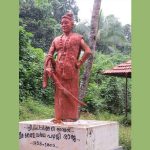KITTUR RANI CHENNAMMA
The Warrior Queen who took up the gauntlet of British Imperialism
As obnoxious laws go, nothing in history could probably outdo the infamous Doctrine of Lapse perpetrated by the English East India Company (EIC) on hapless Indian sovereigns with impunity. The doctrine stipulated that any princely state under the paramountcy of EIC would be automatically annexed by the Company, if the ruler was perceived incompetent or died without a male heir; a cunning ploy to annex the states illegally on one hand and on the other hand, impose an arbitrary regulation that forbid women from being heads of states, which was nowhere in the Indian tradition. Although it was promulgated as law by the Governor General of India, Lord Dalhousie, only in 1848, the EIC had been pretty much indulging in the practice much earlier, wherever it had established its influence (Bizarre as it might sound today, a corporate outfit got away with enacting laws of the land and taking over sovereign states at will). The earliest princely state they tried to snatch away in this manner was Kittur, falling in Belgaum District of the present-day state of Karnataka. The King of Kittur and his only son passed away successively during the years of 1816 and 1824, and the EIC promptly set out to annex the kingdom, employing the doctrine of lapse. They were in for a surprise however, as the widowed but stout-hearted queen, Chennamma, refused to accept their highhandedness and went to war with them. Although the valiant queen’s epic struggle against the British imperialism ended tragically, it left a grand legacy of patriotism and women’s empowerment generations of Indians could emulate.
Born in October 1778 in the village of Kakati in Belgaum District of Karnataka in an aristocratic family, she grew up being trained in martial skills like horse riding, fencing and archery; and married Raja Mallasarja, the King of Kittur, when she was 15. Twenty-three years into her marriage, her husband passed away, leaving her with a son, who too died another eight years on, in 1824. At 46 years of age, she suddenly found herself at the receiving end of the EIC’s doctrine of lapse, with the company eager to snatch her kingdom away. Nonetheless, brave and heroic by inclination, she was having none of it. To thwart the nefarious attempt, Chennamma adopted a boy, Shivalingappa, and declared him heir to the throne, while she remained the Regent. The EIC ordered her to expel the boy, which she refused. She wrote a letter to Mountstuart Elphinstone, the Lieutenant General of their Bombay Presidency, in the jurisdiction of which Kittur fell, trying to reason with him. Elphinstone would not budge and war became inevitable.
Irked by the Rani’s defiance, the Collector and Political Agent of EIC for the region, St. John Thackeray, ordered an immediate attack by EIC troops. A large contingent of the Madras Native Horse Artillery and 5th Madras Native Infantry was moved from Dharwad, where they were stationed, to Kittur on 22 October 1824. Arrogant and overconfident of the contingent making short work of subduing the Rani’s garrison, Thackeray, accompanied by his two sidekicks Elliot and Stevenson, joined the contingent to personally oversee the operation and, more significantly, to ensure that he did not lose sight of the immense wealth the kingdom possessed in its treasury, valued at 1.5 million rupees, which the Company intended to confiscate.
Undaunted, the Rani, ably assisted by her gallant deputy, Sangolli Rayanna and a retinue of other brave officers like Gurusiddappa and Amatur Balappa, kept her cool and braced herself for the attack she knew would be coming, skilfully positioning her gunners, musketeers and swordsmen to defend her fortification. The commander of the horse artillery, Captain C W Black, had his gunners blow open the fort gate and brashly rode in, with the native infantry on his heels. What followed was absolute mayhem. While the Kittur gunners and musketeers picked out the enemy troops at will from their vantage points, their swordsmen charged into the confused enemy ranks and cut them down mercilessly. Even as the enemy was being routed in a swift and bloody engagement, the Kittur soldiers pursued and encircled them, trapping the entire lot within the fort. Those who were not killed were taken prisoner. The British losses were heavy. Captain Black and his two officers, Lieutenants, R Sewell and D B Dighton, were killed along with several of their soldiers and a larger number captured. To add insult to injury, Thackeray himself was killed and his two sidekicks made prisoners.
Magnanimous in victory, the Rani released all the captured soldiers on parole, while holding the two civilian sidekicks of Thackeray as hostages, insisting that the Company undertake to desist from any acts of aggression against her kingdom in future, before they could be released. EIC’s Commissioner for the region, Chaplin, began negotiations with the Rani for their release, deliberately dragging the process on to gain time to mobilise a larger force for a second attempt to storm KIttur. Eventually, early in December, Chaplin acceded to the Rani’s demand and agreed never to invade Kittur again. Accordingly, the two hostages were released on 2nd December.
In a blatant act of chicanery, Chaplin reneged on his promise within twenty-four hours, and a large army of the EIC, comprising over 20,000 men and more than 400 guns, launched an offensive against Kittur, the very next day, 3rd December. (Interestingly, in keeping with the Company’s craftiness in misrepresenting facts, not even Chaplin’s name appears in their records, which state that the hostages were released unilaterally by the Rani on 2nd December for fear of retribution and their offensive commenced on 3rd December. There couldn’t have been a worse instance of not just the unscrupulousness and depravity of EIC officials but their abject idiotism.)
Outnumbered and outgunned though, the lionhearted Rani and her diehard lieutenants fought fiercely, defending their fort. This time around, the civilian official accompanying the army as the watchdog of the treasury was the Sub-Collector of Solapur, John C Monroe (nephew of the more famous Sir Thomas Monroe), who had been designated as Thackeray’s successor. As luck would have it, he too was killed at the beginning of the operations. However, with overwhelmingly superior forces arrayed against her it was only a matter of time before the Rani lost the war. Nevertheless, ferocious fighting raged for almost a fortnight, at the end of which the Rani was captured. Imprisoned at the fort at Bailhongal, the gallant queen died in captivity after five gruelling years of incarceration, on 21 February, 1829.
The Rani’s ever-loyal deputy, Sangolli Rayanna, continued with Kittur’s fight against the British through guerrilla warfare, but finally cornered and captured, was executed in 1831. Shivalingappa, the adopted heir, was arrested by the British, but what became of him remains unknown. Sangolli Rayanna was hanged from a banyan tree at a place called Nandagad in Belgaum District and buried at a nearby spot. Legend has it that they had to dig a longer-than-normal grave for him, because he was an exceptionally tall man of seven feet height. A close friend of his is believed to have had planted a banyan sapling at his burial spot, which has grown into a fully grown tree over the years and attracts many visitors. In Kannada folklore, Sangolli Rayanna enjoys almost equal space as the fiery queen he served.
Rani Chennama’s epic struggle against British imperialism has few equals in Indian history. Though she lost the war, she leaves a legacy of indomitable moral strength for us to defend the land of our birth against foreign invasion and a sterling example for women of India to emulate to assert their rights in our male-dominated society. She is a highly revered historical figure in Karnataka. The Government of Karnataka maintains a park at her Samadhi in Bailhongal Taluk in the district of Belgaum (officially ‘Belagavi’), where she was buried. The people of Kittur commemorate her famous victory over the British forces in October 1824, through a festival held annually during October. The life and times of the Rani and her principal lieutenant, Sangolli Rayanna, have been featured through popular Kannada literature and movies. The Kannadigas celebrate their heroics through popular ballads. The statues of the Rani stand tall in Bangalore and other cities of Karnataka as well as Kittur; and so do those of Sangolli Rayanna in most places. The Rani Chennamma University, Belagavi, established by the Government of Karnataka in 2010, honours the warrior queen’s memory. The Indian Railways has named the train connecting the cities of Bangalore and Kolhapur as Rani Chennamma Express. The main railway station of Bangalore City has since been renamed ‘Krantiveera Sangolli Rayanna Railway Station’; ‘Kranthiveera’ meaning ‘Revolutionary Hero’. A life-size bronze statue of a horseback-and-sabre-drawn Sangolli Rayanna is installed near the railway station. The Indian Coast Guard has a ship named ICGS Kittur Chennamma. In September 2007, a statue of the Rani, donated by Kittur Rani Chennamma Memorial Committee and sculpted by Vijay Gaur, was unveiled in the Parliament Complex at New Delhi by Smt. Pratibha Patil, the first woman President of India; a fitting monument for such an iconic figure in the history of Indian native resistance to colonialism.





